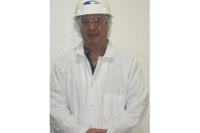Condensation: Silent enemy of food safety

Condensation is an ongoing, physical environment concern in food production facilities. Condensed water can harbor and transport microbes onto food and food contact surfaces, creating big risks for food contamination. In some cases, condensate can carry Listeria monocytogenes and potentially other pathogens as well. In fact, water drips in the wrong places have been directly linked to food safety recalls.
This is of particular concern in chilled and frozen foods plants, where temperatures and busy production traffic patterns often fluctuate considerably in different areas of the facility, creating changing condensation challenges. As we know, condensation problems can vary seasonally, and along with them, food safety issues.
What can a plant manager do to prevent and remove condensation?
The first step is to identify the causes and sources of condensation. These are common trouble spots where water condenses—that is, moves from water vapor to a liquid form:
- Freezer entrances and exits, those locations where there is an abrupt temperature transition.
- Overhead pipes, especially coolant pipes, that are installed near food contact areas and not properly insulated. Pipe wrapping material technology has improved dramatically, so one solution for modern facility pipe networks is to properly wrap pipes with the appropriate material. It’s also important to control and channel condensate water to proper drain locations.
- Mezzanine areas and enclosed, multi-deck locations that can create “air dead spots” and thus increase risks for condensation droplets to form on overhead surfaces.
- Airflow in and out of rooms or doorways can cause humidity imbalances within the production environment; this is a big challenge in many plants. It’s recommended to develop an HVAC air handling “budget” for the entire processing facility and modify as necessary.
- Drip pans and condensate collection trays can also harbor microbial contaminants. Ensure that all overhead cooling unit drip pans are cleaned regularly and have good drainage. Use a chemical block—usually a quaternary ammonium or “quat” compound—to prevent microbial growth in collected condensate water.
If you are experiencing condensation issues in your production facility, consult with a sanitation expert who can help you physically inspect and audit the plant, identify likely problem areas and develop a plan to mitigate them.
Removing condensation
Condensation removal can be challenging. Removal by a sanitation crew needs to coordinate with pre-operation inspections and final sanitizer application. Remember that condensation on overhead units or equipment above food contact surfaces must be removed before final sanitizer application. Your sanitation services provider can develop processes and protocols for condensation removal and sanitation throughout the plant. Professional sanitation personnel are trained to remove condensation safely and effectively.
The biggest obstacles to managing condensation issues may be managing and removing condensation—and keeping all areas sanitary—while production is underway. Production crews need to be trained in best practices and use proper tools for removing condensation during operations.
Whether you are removing condensation before or during production shifts, cleaning materials and equipment need to be clean, sanitary, non-shedding and non-scratching to abate possible recontamination. Use clean paper towels or clean, non-shedding wipes or towels. Make sure extension poles are clean and sanitized.
Take special care when using air wands and compressed air to dry wet surfaces and equipment. Carefully control compressed air streams to ensure that tiny condensate droplets do not accidently blow back onto food contact surfaces. And, always use clean, filtered air to prevent cross-contamination.
Sampling the air in the production environment can help determine product quality risks due to airborne dust and any associated microbial contaminants. Use microbial air testing results to identify risk locations and types of contaminants present.
Preventing condensation
To prevent condensation from forming, start by assessing and monitoring the airflow in and out of the food production facility. Measure fluctuations in relative humidity levels as you move through the production area. Look for obvious challenges from freezer openings, cooling units, piping and pipe wrap and ceiling conduits. Check cooling units to ensure the proper drip pans and quat chemical blocks are in place.
Armed with this information, you can determine the best ways to prevent condensation, especially during operational shifts. Sometimes “in-process” methods of condensation abatement are needed, such as use of plastic sheeting to catch condensation drips. However, be sure to consider long-term solutions rather than looking for temporary fixes.
Your sanitation services provider may be able to provide guidance on both preventing and controlling condensation. Look for a supplier who is experienced in maintaining sanitary conditions in diverse food production facilities where condensation may be an issue.
Looking for a reprint of this article?
From high-res PDFs to custom plaques, order your copy today!





